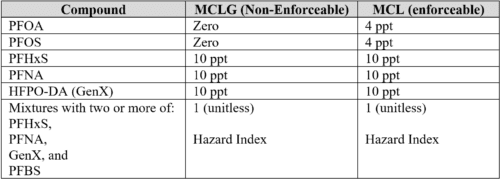USEPA Requires Monitoring and Treatment to Limit and Reduce PFAS in Drinking Water
April 10, 2024
Environmental Law
Today, the U.S. Environmental Protection Agency (USEPA) announced the final National Primary Drinking Water Regulation establishing the first national legally enforceable drinking water standards (Maximum Contaminant Levels or MCLs) for six per- and polyfluoroalkyl substances (PFAS), commonly referred to as “forever chemicals,” including PFOA and PFOS.
Under the final rule, the MCLs for PFOA and PFOS are set at 4.0 parts per trillion (ppt or ng/L). For PFHxS, PFNA, and GenX the MCLs are set at 10 ppt. In addition to the MCLs set for these individual PFAS compounds, the final rule also utilizes a “Hazard Index” MCL where the maximum limit is based on any mixture containing two or more of PFHxS, PFNA, GenX, and PFBS. There is a complex formula for determining the Hazard Index based on the MCLs, which we previously reported on here. USEPA intends to provide water systems with a web-based form that will automatically calculate the Hazard Index to assist with determining compliance. The final rule also prescribes non-enforceable Maximum Contamination Level Goals (MCLGs) for the respective compounds. These MCLGs are summarized along with the comparative enforceable MCL for each compound in the table below.

The final rule requires public water systems to monitor for the above-listed PFAS compounds, with completion of initial monitoring required by 2027, followed by ongoing compliance monitoring. If monitoring shows drinking water levels exceeding the MCLs, public water systems then have five years from the final rule (by 2029) to implement solutions that reduce PFAS contamination. In 2029, public water systems that have PFAS in drinking water that violate one or more of the MCLs must take action to reduce the level of PFAS in their drinking water and must provide notification to the public of the violation.
While there are existing methods available to monitor for the constituents (e.g., method 1633 for PFOA and PFOS), treatment technologies to remove the constituents (e.g., granular activated carbon (GAC), anion exchange resins (AIX), reverse osmosis (RO), and nanofiltration) remain expensive, a significant concern to regulated entities. USEPA estimates that between 6% and 10% of the 66,000 public drinking water systems subject to this rule may have to take action to reach compliance, which is estimated to cost approximately $1.5 billion annually. Notably, there is flexibility in the final rule as USEPA does not dictate how water systems remove the contaminants, allowing systems to determine the best solutions for their community. In some cases, USEPA anticipates allowing systems to close contaminated wells or obtain new uncontaminated sources of drinking water as an alternative to treatment.
For small, rural, and disadvantaged communities, USEPA is poised to provide technical and financial assistance to assist with monitoring and compliance. Through the Bipartisan Infrastructure Law, USEPA is making available $9 billion specifically for tackling PFAS and emerging contaminants ($1 billion of this can be used to assist private well owners). An additional $12 billion is available under the Infrastructure Law for general drinking water improvements. Additionally, USEPA has a nationwide Water Technical Assistance Program to help small, rural, and disadvantaged communities to access federal resources by working directly with water systems to identify challenges like PFAS; develop plans; build technical, managerial, and financial capacity; and apply for water infrastructure funding.
While these requirements are not surprising given the USEPA’s PFAS Strategic Roadmap and the 2023 proposed rulemaking to establish MCLs for PFAS (previously reported here), actions required for public water systems under the final rule are likely going to require significant investment of money, time, and human effort. Downey Brand is closely monitoring this effort, as well as the myriad of other federal and state rulemakings, including: inclusion of PFAS chemicals as hazardous waste under the federal Resource Conservation and Recovery Act and California’s own proposed drinking water standards. For any questions about California or USEPA’s efforts to regulate PFAS, please contact us.
